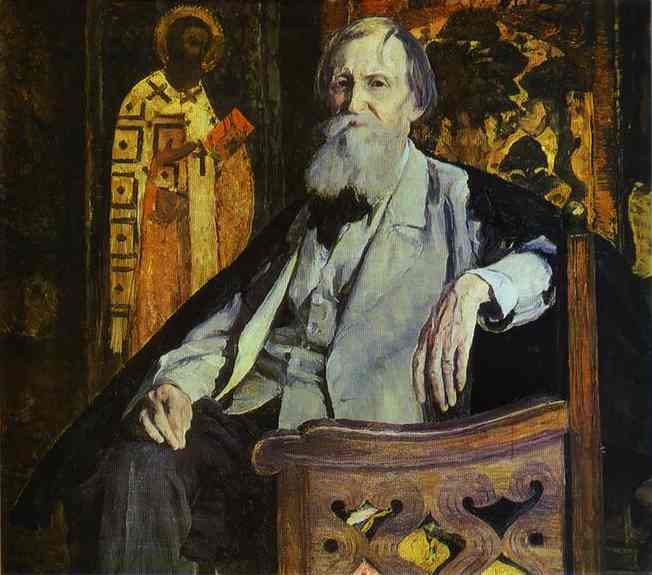The directory «Artists»
Vasnetsov Victor Mikhailovich
(1848—1826)

Son of a village clergyman, Victor Mikhailovich Vasnetsov prepared himself for the same career, but the passionate love for art brought the 19-year-old student of ecclesiastical seminary to St. Petersburg's Academy of Arts. During his years (1868-75) in the Academy Vasnetsov got a thorough professional training; an especially big role in his education was played by professorPavel Tchistyakov.
Victor Vasnetsov started as a scene painter; the influence of Fedotov and Perov in his early works is evident Moving House (1876), At a Bookseller's (1876), News from the Front (1878), A Game of Preference (1879). In the late 1870s early 1880s, Vasnetsov tried himself in historical genre Battle of Slavs and Scythians (1881), After Prince Igor's Battle with the Polovtsy (1880). He borrowed the subjects from ancient history. He found another source of subjects in Russian mythology – legends, ballads, fairy-tales. Vasnetsov was born and grew up in a northern Russian village and almost to the age of 20 lived in an environment where the ‘folklore outlook’ was still alive; his very soul was steeped in the poetry of Russian epic literature. He wasn't only the first artist to use subjects from folklore, but also the first to borrow methods and techniques from national folk art. Thus he became the founder of new style in Russian painting.
Vasnetsov was an active member of the Abramtsevo circle (Abramtsevo is the estate of the well-known patron of arts Savva Mamontov), which sought to revive national traditions. Many undertakings by the Abramtsevo Colony, whether the construction of a church at Abramtsevo, where Vasnetsov, as the designer, first coped with the problem of creating a whole, integral ensemble, or the erection of the ‘Witch’s Hut” (also to his design), or the sets and costumes for the production of Alexander Ostrovsky’s lyrical fairy-tale The Snow Maiden and for Nikolai Rimsky-Korsakov’s opera of the same name, staged at Mamontov’s private Opera in 1885, were to become milestones not only for Vasnetsov but also for the Russian art in whole.
In 1882, Vasnetsov received a commission to produce a decorative panel for the rotunda of the Historical Museum in Moscow, which was his first big monumental project. Yet the most significant and time-consuming work of this type was the decoration of the Cathedral of St. Vladimir in Kiev, which Vasnetsov began in the autumn of 1885 at the invitation of the art historian Adrian Prakhov, who supervised the construction of the cathedral. Vasnetsov jumped at this offer as it gave him the opportunity to create an integral ensemble comparable to those done by ancient fresco-painters. Work on the decoration of the cathedral took over 10 years, during which Vasnetsov executed nearly 400 sketches and studies. The murals he painted with his assistants covered almost two thousand square meters. Fulfilling this assignment Vasnetsov relied on his favorite range of motifs and characters, painting the walls with the images of princes Vladimir, Alexander Nevsky, Andrey Bogoliubsky, Princess Olga, the chronicler Nestor, and other outstanding figures from Russian history. In the late 19th and early 20th centuries, Vasnetsov actively worked in different fields. He produced a number of architectural designs, including those for his own house in Moscow (1894), for a pavilion at the World Fair in Paris (1898), and for E. Tsvetkov’s house on the Moskva River (1901-03), as well as designs for decoration of the Great Kremlin Palace (1898), the Faceted Chamber (1901-03), and other buildings in the Kremlin. In 1904, he designed the façade of the Tretyakov Gallery.
During the last 20 years of his life Vasnetsov turned to his favorite lyrical subjects inspired by Russian fairy-tales. These include Three Bogatyrs (1898), The Frog Tsarevna (1918), The Tale of the Sleeping Beauty (1900-26), and the Unsmiling Tsarevna (1916-26). Thanks to his enchantment with Russian epos and history, thanks to his search for a genuinely Russian pictorial idiom, Vasnetsov was able, of the eve of the 20th century, to inspire many artists to reaffirm the moral and aesthetic ideals of the people, to revive Russian’s spiritual legacy.
His painting influenced greatly the development of modernism and symbolism in Russian painting and poetry.
Russia, 1998, Tsarevich Ivan on Grey Wolf